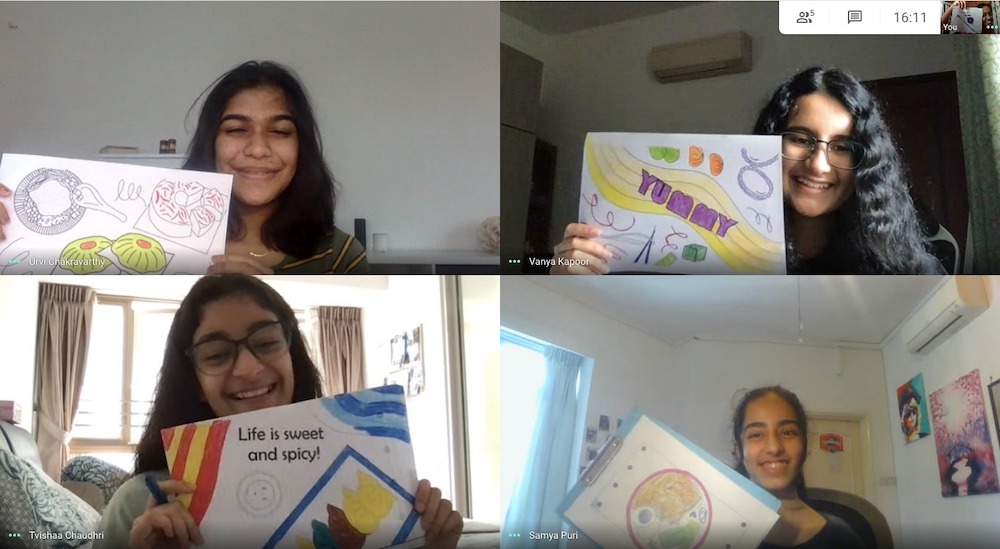By Kelly Ng //
Frequent hospital visits when her father was undergoing a kidney transplant in 2018 made Aanya Rao realise how daunting the monochromatic walls and massive hospital equipment were.
“Healthcare centres have become synonymous with ‘home’ for many of these patients and even healthcare workers, and I felt it is only fair that they have a vibrant and positive environment,” said Aanya, an art enthusiast who hopes to enter the medical field eventually.
There is a growing body of evidence that the arts can promote mental health to build capacity for managing one’s emotional well-being. For instance, a study published in the US in 2019 had found that visual art promotes health, wellness and fosters adaptive responses to stress. In another study, cognitive neuroscientists found that the process of creating art reduces stress markers and induces positive mental states.
Amidst the COVID-19 pandemic last year, Aanya, now 15, embarked on an endeavour to incorporate more art in healthcare settings. Art:Connect was thus born – it comprises a group of student volunteers who curate visual art pieces, such as paintings and photography, for display inside healthcare institutions in Singapore.
She started by first rounding up her friends and schoolmates. The core team comprises Aanya, Urvi Chakravarthy, Siya Sharma and Kavya Nair. In less than a year, the group has grown into a well-organised team with 30 volunteers across three functions: art curation, outreach, and communications and marketing.

The team has worked with healthcare institutions to use these art pieces. Apart from displaying them in the centres, some also use them as colouring templates for patients and residents. Art:Connect volunteers also conduct art workshops for patients, teaching them origami, sketching, or simple crafts. In December 2020, Art:Connect also had an opportunity to paint murals at a nursing home.
The organisations they have collaborated with include senior care facilities such as Sree Narayana Mission (Singapore), St Luke’s Hospital, and Lions Home for the Elders.
In June, the team ran an Organ Donation Awareness Programme, with the National University Centre for Organ Transplantation, to raise awareness about organ donation. Art:Connect launched an art competition in conjunction with the programme, for which selected artworks would be exhibited at the National University Hospital Main Building (Lobby B).
15-year-old Aanya told The Tapestry Project she has seen the power of art to not only serve as a medium of restoration for patients and facility residents, but also as a bridge between the younger volunteers and their older beneficiaries.
Urvi, who leads the Art:Connect’s communications and marketing team, said the first art workshop she led over a virtual platform was the most memorable. “I felt very stressed because the lady resident I was (assigned to help) did not speak. But at the end of the session, she finally looked up and proudly showed us her work. It was very moving,” said the 16-year-old.
Vanya Kapoor, who manages social media for Art:Connect, said visual arts is an accessible medium for everyone.
“I like that there is no right or wrong in art; you don’t need to be an artist or to be ‘good’ at it. And yet it can empower the young and the elderly to express themselves,” Vanya said.

In the near term, the team plans to customise art packages – such as coming up with drawing or craft templates – for the seniors, and also hopes to diversify their team. The team started out comprising Aanya’s schoolmates and neighbours, but they have managed to interview and recruit volunteers from across the island in the past few months.
Asked about their challenges managing the organisation as full-time students, Aanya said it was initially tough to strike professional relationships with her friends. “At one point, our friendships became a bit more complicated but we soon learnt to keep our Art:Connect commitments and friendships separate,” she said.
The team was also conscious about caring for their own mental wellbeing while juggling work for the organisation, studies and other aspects of their lives. It helped that members were adaptable and empathetic to one another’s personal commitments.
“We have a very flexible schedule when it comes to our weekly team calls and tasks as our directors are very approachable and will readily adjust our workload according to any school and personal reasons, if required,” Vanya said.
This writer was particularly impressed by the team’s professionalism in running Art:Connect as teenagers. The sub-groups meet at least once a week over Zoom to discuss their tasks, while the whole Art:Connect gathers together virtually every two to three months.
Another difficulty comes in the form of not being taken seriously. “Sometimes, our potential partners are shocked that we are so young, and it’s difficult for them to understand that we are capable of what we want to do,” Urvi said.
Aanya, who has never led an initiative of her own, said Art:Connect has helped her learn to listen better, be assertive in making decisions, and take responsibility for her decisions. The team also keeps her going.
“While my personal aspirations were what got this started, right now, my biggest inspiration is our team of student volunteers themselves,” she said.
In the long term, Art:Connect hopes to gather more young people to come on board as well as to expand their network of collaborators in the healthcare sector. They also hope to broaden their offerings to include performing arts like music and dance, so as to enhance the healing environment in healthcare institutions – not just physically, but mentally, too.
Read more of our Tapestry Stories here.

